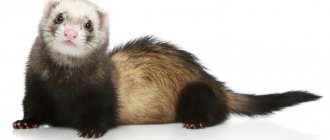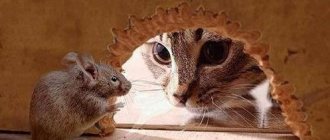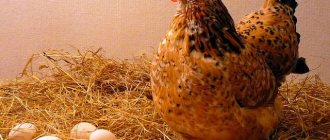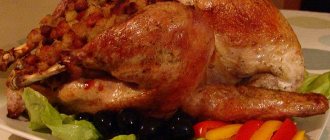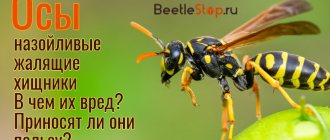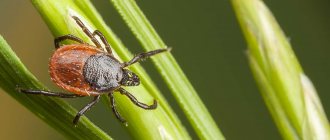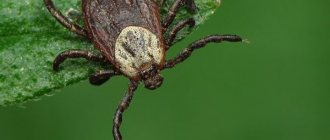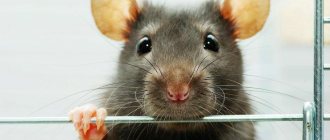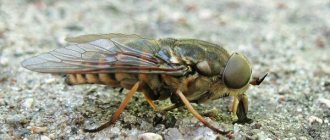How to distinguish a ferret from a marten
Those who decide to get a ferret often ask how it differs from a marten.
Outwardly, these animals are very similar. How to distinguish a ferret from a marten. Both of these animals belong to the mustelidae family, so it is quite difficult to distinguish them, especially for a person who does not know their characteristics.
Ferret
The ferret has the same image as all representatives of mustelids. He has a fairly stocky body, an arched, stately body.
The ferret's coat is distinctive; it has axial hairs that hide the actual size of the body. With such a “fur coat” the animal looks more powerful than it actually is. The length of males can reach 50 centimeters. Weight is within 1.5-2 kilograms.
Wild individuals have a special coat. In winter it is dense and long, and in summer it is soft and tousled. The color of the main hair is brown-black, the undercoat has a yellow tint.
The sides and back vary in color, from black to light brown. The chest, paws, throat, belly, tail have light shades.
The coloring of the animal's face is very similar to a mask. The eye area and between are black. On the forehead and front of the head the hair is lighter in color. There is a white border along the edge of the ears.
Habitat
Wild animals live in forest-steppes, forests, and steppes. On the territory of the Eurasian continent you can meet a ferret in any natural area.
Marten
She is particularly slender. Body length can reach 60 centimeters. Weight about 1.5 kilograms. The animal's tail is approximately half the length of its body. Long, graceful paws have feathering in the winter season.
The forest beauty spends a lot of time in the trees. That's why her claws are long and curved. The head is small, the muzzle has pointed features. The ears are round.
In winter, the marten has reddish hair, with gray fluff visible under it. The paws are dark, the rest of the body does not differ in color. The ears have a light cut at the edges.
Habitat
The animal settles in forests of various types.
Similarities of animals
In addition to the above differences, these two animals have a lot in common in their diet. They prefer:
- Birds
- Small rodents
Main differences
The most important difference is that it is almost impossible to accustom a marten to domestic life. Martens have a more aggressive character. The ferret confidently claims to be a pet, since these representatives of mustelids have an innate predisposition to socialization.
Don't worry, they won't sell you someone instead of a ferret. Martens cannot be purchased at a pet store. And the differences between ferrets and martens are immediately visible:
- Fur coat color
- Face shape
- Hair size
- Ear shape and color
- Type of claws
- Body size
- Paw length
- Character
How to distinguish animals when purchasing
If you are still in doubt, there is a great method for distinguishing between these animals. It is enough just to take the animal in your arms.
The ferret will study you, sniffing you, he will show ordinary interest. The marten will immediately begin to escape.
Martens do not survive in domestic conditions. Therefore, these animals are not kept as pets.
The marten vitally needs freedom.
She is in demand among hunters only because of her fur. Selling the marten as a pet simply makes no sense.
When choosing a ferret as a pet, you should pay attention to:
- age
- eyes (they should not be cloudy or filled with pus)
- the coat should be shiny
- legs are straight
- The puppy should not show strong aggression
- wet nose
- clean ears
- there should be no dirty spots under the ponytail
- back arched
- gait without lameness
Based on these signs, you can not only choose a healthy pet, but also get yourself an affectionate ferret.
In any case, if you have any doubts, it is better to refuse the purchase. It is also important to purchase the animal not from hand at the market, but in specialized places:
- nurseries
- from breeders
- in pet stores
Buy ferrets only where you can meet the baby’s parents and all the necessary documentation.
Habitats
Animal populations were distributed in the following geographical areas:
- Steppe ferrets in eastern Europe (Hungary, Romania, Czech Republic, Slovakia and Ukraine), Central Asia, Russia (from the Ural Mountains to the Far East) and in the eastern regions of China.
- The forest ferret can be found almost everywhere in Eurasia, especially west of the Ural Mountains.
- The central part of North America, namely east of the Rocky Mountains, is where black-footed ferrets live.
Ferrets or weasels
Ferrets, or weasels (lat. Mustela) are a genus of mammals of the mustelidae family. In addition to the trochees themselves, the same genus of predators includes mink, weasel and ermine.
The domestic ferret is a domesticated ornamental animal that has lived with humans for many generations. It is believed that these animals were domesticated in ancient times, but in reality they have been kept as useful pets for about 3-4 centuries.
There are 3 types of ferrets distributed in Eurasia and North America; in Russia there are two species: the forest or dark polecat (lat. Mustela putorius) and the steppe or light polecat (lat. Mustela eversmanni).
Body length in males is up to 50 cm, in females up to 40, tail up to 18 cm. Since ancient times, the albino form of the dark polecat, furo, has been domesticated (depicted in Leonardo da Vinci’s painting “Lady with an Ermine”). It was bred 2000 years ago in Southern Europe and for a long time replaced the cat; it was also used for hunting rabbits. He has a calm, non-aggressive disposition.
Adult ferrets lead a solitary lifestyle in nature. Predators. The forest ferret's main food source is small rodents, especially gray voles. The steppe ferret also destroys larger rodents - gophers, hamsters, and pikas. Poultry houses are attacked near housing.
Ferrets are typical “family” animals that are friendly not only to their owner, but also to his family and friends. The animal easily finds contact with children over 7 years old and becomes a cheerful playmate for them. Adults need to monitor the relationship between children and the ferret, help in caring for the animal and explain to the child the rules of communication with the ferret. For children under 6 years of age, this animal should not be purchased, since both the child and the ferret have an excitable temperament and can harm each other.
In terms of everyday behavior, domestic ferrets are very smart and funny. Even as adults, they do not lose their playfulness with age and remain cheerful and curious all their lives. The average lifespan of a ferret is comparable to that of a cat - about 10-12 years.
Ferrets are highly social creatures. They sleep a lot, often up to 14 hours a day. But when they are active, they want to interact with people or other ferrets. A ferret owner should be able to spend several hours a day playing with the animal. Ferrets have a lifespan of 7-9 years, so you'll have to keep your furry friend entertained daily for quite some time. And if you neglect this, then the ferret will find something to do for himself - digging flowers, throwing a trash can... You should devote time every day to communicating with your ferret. There are numerous ways to keep your ferret entertained, from playing tag to playing tug of war with an old sock. Ferrets also love to play with other ferrets. If you have several ferrets, you will often find them bouncing around each other, or hear the sounds of fighting coming from under the sofa :), or see them cuddled in a hammock while sleeping.
Content:
The minimum cage size is 50x70x50. Cages sold in pet stores have longitudinal bars - ferrets often try to break such a bar and break their teeth. We would like to recommend you cages made from building mesh - the cell size is 2x2 cm. Such a cage can be purchased at the Poultry Market, the price ranges from $50 to $200.
If you buy a cage for a ferret at a pet store, then pay attention to the doors, some cages have very small ones, and you need to clean the tray every day and it simply will not fit through the small door and you will have to disassemble the entire structure. When buying, try to imagine how you will arrange the items in the cage - where the tray will be, where the house or bedding is, where the bowl is - and you will immediately understand whether it fits or not.
On the floor of the cage, if it is metal, you need to lay linoleum. You can use special tablecloths for the table (not soft, but holding their shape), size approximately 80x60, they come with various patterns, price - 60-70 rubles per piece.
Don’t forget to buy a tray (with high sides), a water bowl for rodents and a couple of bowls (preferably ceramic ones - so that the ferret can’t drag them around the cage and bang them on the bars).
Buy litter for a litter tray - cat litter will do just fine. You will also need some bedding in the cage for your ferret to sleep on. Do not use sawdust under any circumstances - ferrets may be allergic to it; an old T-shirt or sweater will do; you can also hang a hammock in the cage - ferrets love to sleep in them. Don't forget about toys - pet stores sell very cute mice for cats, or balls with a ball inside. Ferrets love small plush toys, just remove the plastic parts - the ferret can chew them off and swallow them.
Keeping a ferret at home is quite simple if you take into account some features in advance and prepare for them. The ferret is a semi-burrowing small predator that has an innate interest in all kinds of holes and crevices and is distinguished by a very active temperament and developed curiosity. Therefore, in order to avoid possible troubles, even before you get a ferret, you should prepare the house taking into account certain requirements.
Habits and lifestyle
The wild ferret is a predatory animal, which is expressed in its distinctive features - aggressiveness and courage. They will not be intimidated by a confrontation with a larger opponent. Fearlessly taking on a fight is in the order of things for them.
In addition, ferrets are also characterized by ruthlessness towards their prey - by attacking a bird’s nest, the animal will satisfy its hunger and then kill every inhabitant. And all this is said about a ferret - an animal that from the outside can be called very cute.
Ferrets do not form packs, but maintain contact with their closest relatives. Moreover, in these relationships one alpha male dominates, which is more clearly expressed both during normal times and during mating. But each of the individuals has its own territory for living, which they mark by making regular rounds.
The activity of the animal occurs at night. During the day the animal sleeps, having previously dug a hole for itself. The burrow can be permanent - with a small hole and a chamber, or temporary - if movements at dawn find the animal far from home. In this case, these small predators do not shy away from using other people’s holes - hare or badger ones. And when the weather is bad, the ferret can spend several days in the hole without leaving.
What is the difference between weasel, marten and harek from each other?
It's easy and interesting to communicate here. Join us!
The genus Ferrets in Russia includes eight species: weasel (Mustela nivalis), ermine (Mustela erminea), solongoi (Mustela altaica), weasel (Mustela sibirica), American mink (Mustela vison), European mink (Mustela lutreola), black polecat (Mustela putorius) and the steppe polecat (Mustela eversmanni).
All representatives of the ferret genus are animals with a flexible, elongated body, very graceful and agile, and differ from martens by the presence of white color at the tip of the muzzle. The ears are small and round.
The body length of the steppe polecat is 29-52 cm, the tail is 7-18 cm. The top and base of the tail are pale sand, sometimes with a dark coating; the lower body, legs and end of the tail are black and brown. There is a dark pattern on the muzzle; lips, nose and edges of ears are white. The eyes glow faintly at night with a copper-red light.
Weasel (Mustela nivalis) is the smallest animal of the Carnivora order: body length 11-26 cm, tail 2-8 cm.
The color in summer is sharply two-colored: the upperparts and legs are brownish-brown, the underparts are white. In winter, the entire animal is snow-white. Steppe and Caucasian weasels are often pale reddish and do not turn completely white in winter. Very rarely there are several dark hairs at the end of the tail. Males are almost twice the size of females. The eyes glow faintly at night with a copper-red light.
Pine marten (Martes martes) - Animals the size of a small cat or slightly larger. They differ from ferrets, minks and weasels by a short triangular muzzle, large (longer than 3.5 cm) slightly triangular ears, the absence of white on the lower lip and a light spot on the chest. The body length of the pine marten is 33-58 cm, the tail is 17-26 cm. There is almost always a large, sharply defined yellow (very rarely white) spot on the throat. The color ranges from brownish-fawn to dark brown, the legs are dark. The eyes glow faintly at night with a copper-red light.
https://zoomet.ru/sid/sidorovich_1.html
https://old.ferret.ru/mustelidae03.shtml
https://www. zoopicture. ru/ lesnoj-xorek/ [spaces need to be removed]
Different species of the same mustelidae family.
Even in ancient Greece, weasel lived in houses and caught mice. It is small and even an adult can be tamed, although it is weaker than the Solongoi. And the rabbits were clearly being crushed by the ermine. Horik does not change color that much. I advise you to go to www.inferret.ru.
This is a site on mustelids and you can find out everything there. Some of the respondents are scientists and with scientific degrees. But most are very knowledgeable.
weasel - body length - 13-28 cm, tail - up to 9 cm
marten - about the size of a cat
harek - Body length in males up to 50 cm, in females up to 40, tail up to 18 cm
see Wikipedia for more details)
They just differ in size and color. look at their photos in the encyclopedia
Enemies
In winter, the main dangers for ferrets are wolves and foxes. An encounter with wild cats, birds of prey (eagles, golden eagles or night owls), as well as large snakes can also become unpleasant.
Among the creatures dangerous to ferrets, humans can also be mentioned. Its impact, namely the destruction of nature reserves, the construction of roads and housing in wild areas, can cause the disruption of the ferret ecosystem and the destruction of their habitats.
Appearance
The weasel is the smallest in the mustelidae family. Thus, the lesser weasel grows the size of a palm (11 cm), and the length of the common weasel is 21-26 cm.
This is interesting! The ermine is somewhat larger than a weasel. True, sometimes there are individuals equal to it in length, but in general the ermine is still larger/heavier and is capable of growing up to 36 cm.
Both predators are colored the same: in summer - brownish-brown, in winter - snow-white. But the ermine is distinguished by a specific detail - the black tip of the tail, especially noticeable among the snow and ice. Both animals have a similar anatomical structure - an elongated body, a narrow head, short legs and neat rounded ears.
If you happen to spot one of these mustelids, the first thing you need to pay attention to is the tail. A well-defined tail 6-10 cm long, almost a third black, will tell you that this is an ermine. If the flashing creature wiggles its short appendage (3-4 cm), then you have met a weasel.
How to catch a weasel: ways to catch small predators from a chicken coop
It is not so difficult to catch poultry house robbers: knowing their habits and preferences, you can weaken their onslaught. For centuries, farmers have been using traps and other traps to catch small predators.
Homemade devices
How to get rid of weasels - quite simple! To do this, you only need a few items that are always at hand.
Setting up a homemade weasel trap
| Step | Description |
| 1 | It is necessary to cut off the bottom and top of the bottle. |
| 2 | At one end of it you should install bait in the form of one of the mustelids' favorite foods: a piece of fresh lamb or pork will be an excellent bait, since they will not be able to help but react to the strong smell of blood emanating from it. |
| 3 | A chair should be placed in the place where animal tracks were found. |
| 4 | Place the bottle on the edge of the chair. |
| 5 | You need to place a bucket under the chair, into which the animal tempted by the bait should fall. In this case, the lid should be secured so that it slams shut at the slightest vibration. |
It is important not to miss the moment when the animal falls into the trap in order to have time to fix the bucket lid in a timely manner. Otherwise, the animal can get out of it and all efforts are aimed at solving the problem: how can you catch and get rid of a weasel in a chicken coop? ,
will be in vain.
It does not matter how exactly the predator was captured, after capture it should be released away from its area.
Large mousetraps
The list of items that help in solving the question continues: what to do to prevent a weasel from getting into your chicken coop, a large mousetrap.
It is difficult to find an animal that would not find itself in a trap containing a delicious piece of meat. The Zürner rat trap is very popular among farmers.
Prices for repellers and traps for birds and rodents
Repellers and traps for birds and rodents
You can buy it in a store: the average market price is 1,200 rubles, or you can make it yourself. The manufacturing process is quite simple and does not require large financial costs. It is a small but capacious box made of boards. The peculiarity of this trap is the bridges connecting 2 windows located parallel to each other. They form a solid corridor hanging in the air. Metal hooks with bait are installed above the cover of the device, located above the junction of the two bridges. The animal climbs onto the bridge in order to swallow the bait and falls inside the box.
Repellers
As a preventative measure, you can try to scare away the unwanted predator. An electronic repeller works well for this purpose and should be placed in the poultry house or in the area adjacent to it.
Prices for various types of electronic rodent repellers
Electronic repeller
The device emits low-purity signals that provoke panic attacks in animals and a desire to get out of the area as quickly as possible.
As an alternative, you can install a light with a built-in motion sensor, which will respond to the approach of intruders with noise and sound warnings.
Traditional methods
Measures to protect yourself from a little robber can be quite simple. For example, tar is considered an effective remedy. Rural farmers believe that walls coated with this resinous product will emit a weasel-repellent odor. However, this method is rather dubious: the weasel can get into the chicken coop through the roof or dig a hole, thus not coming into contact with the walls.
Footprints
As soon as the first snow falls, the naturalist has an additional opportunity to distinguish between a weasel and an ermine - by their tracks and patterns of running. Experienced hunters know that weasels often place their paws in pairs (“doubles”), and a jumping stoat leaves prints of three paws (“triples”).
This is interesting! They also say that the weasel walks with a double leg: the hind paw hits the impression of the front paw, covering it. The ermine, on the contrary, more often switches to a three-beam and even a four-bead, especially when gaining greater speed.
The most obvious tracks (with details) are visible in wet, shallow snow. In both animals, the print of the front paw is slightly smaller and rounder than the print of the hind paw. The sizes of the tracks left by these predators also vary. In a weasel, the print of the hind paw is approximately 3 * 1.5 cm, the front one is 1.5 * 1 cm, so the depression from a pair of paws occupies 3 * 2 cm. The ermine's limbs are usually larger, which also affects the size of the footprint: the print of the front paw is closer to 3.3*2 cm, and the rear one - to 4.4*2.3 cm. It is easy to distinguish the tracks of the average representatives of the ermine and weasel - the former will always have larger ones.
Difficulties arise when comparing prints of a large weasel and a small ermine: the difference between them is so insignificant that even fishermen get confused. Identification of footprints is complicated not only by the similar size of the animals, but also by the surface where the prints are found. Their contours blur (giving extra volume to the tracks) both on dry sand in summer and on loose snow in winter. You can also distinguish between a weasel and an ermine by the length of its jump: in the former, when moving slowly, it is 25 cm and doubles when accelerating.
An ermine in a calm search jumps 0.3-0.4 m, making record jumps of 0.8-1 m when switching to a fast gait. Both predators like to change direction when they are actively searching for food.
The trail is observed along the surface: it either crosses a ditch, then turns towards the bushes, goes out onto an icy swamp, or, making an arc, returns to an already examined place. The weasel more often and more readily than the ermine disappears under the ground/snow, not appearing on the surface for a long time. Due to its compactness, the animal quickly runs through snowy passages and burrows, chasing small rodents.
Methods for entering a chicken coop
The weasel can get into the house through any accessible hole. A crack in the foundation or an unnoticeable hole in the wall - all this helps an uninvited guest get into the chickens. If the walls of the poultry house do not have holes, but there are boards that have rotted from time and moisture, the weasel will easily gnaw them.
The favorite way for weasels to enter the poultry house is through rat and mouse holes, so protecting the yard from these predators is no less important than the chicken coop itself. If there are no cracks or holes in the area, the animal is able to get through the system, or dig an underground hole with its sharp claws.
Weasels rely on small rodents for their diet.
Nutrition
Ermine and weasel are true predators with excellent hunting reflexes, preying on any sized living creature (usually warm-blooded) and, in its absence, switching to other vertebrates and mollusks/insects. Zoologists consider the weasel, which has less strength, to be more competitive, since it is more compact and fits into narrow burrows that are inaccessible to the stoat. On the other hand, the small size of the weasel’s body is responsible for more intense energy exchange, and here the ermine is in an advantageous position.
Important! In cold weather, energy consumption increases and hunting becomes more difficult, but the ermine tolerates the winter depletion of food supply much more easily than the weasel.
In addition, the ermine is saved by its broader (compared to the weasel) food specialization - it is not squeamish and quickly switches to other food (amphibians, birds, insects and even carrion).
This is where the differences end - if there is a lot of prey, both predators do not know how to stop, exterminating the same voles “in reserve.” Occasionally, the weasel and ermine actually set up storehouses, dragging their victims there, but often they remain uneaten. Both mustelids are also known for killing animals with a strong odor, such as moles and shrews.
Signs of an uninvited guest
A weasel seen near a poultry house is a harbinger of the imminent death of pets. As she opens the hunting season, she displays skillful tracking tactics and excellent knowledge of camouflage. Considering the fact that, like a ferret, it is impossible to take it by surprise, you should prepare for defense.
When the first snow falls, it is quite easy to detect signs of uninvited guests. Animals leave specific two-point tracks: they move by jumping, after which characteristic marks appear on the snow surface. By the distance between the paw prints, you can calculate which particular species of mustelid was visiting:
- weasel - 20-30 cm;
- marten - 30-40 cm;
- ferret - 50-60 cm.
As practice shows, it is the ferret that causes the greatest damage to farmers, since compared to other family members, it is the most bloodthirsty and ruthless.
Sexual behavior
Geneticists have repeatedly asked the question “is it possible to cross a weasel with an ermine” and have come to the conclusion that, most likely, it is not. This is explained not only by discrepant periods of reproduction, but, above all, by differences at the genetic level (with undeniable external similarities).
True, the details of weasel reproduction have been studied less thoroughly than those of the ermine. It has only been established that the mating season for weasels occurs in March, gestation lasts 5 weeks and ends with the appearance of 3-8 (usually 5-6) cubs. The ermine rut starts as soon as the snow melts and lasts until September.
This is interesting! Female ermine are characterized by “delayed pregnancy”: the seed is preserved inside the body in order to fertilize the egg after a while (with an abundance of food and good weather).
Fetal development can begin with a delay of 196-365 days, and gestation itself takes 224-393 days - these periods are surprising not only for the mustelid family, but also for mammals in general.
It will also be interesting:
Another phenomenon has been noted in the reproduction of ermine - males who come across a nest with a female cover not only her, but also her newborn daughters. “Grooms” are not embarrassed by the infancy of “brides”, who do not have time to see and gain hearing before the first sexual intercourse. Thus, many females, by the time of their fertility (2 months), retain “preserved” sperm inside the body and do not need a partner.
They just need to start the process of fertilization, which smoothly flows into gestation. Small stoats also have their own peculiarity - this is the “cohesion effect”, when the cubs join into a dense ball that is difficult to separate from the outside. This is how newborns retain the warmth they need at this tender age.
Reproduction
The mating period varies depending on the type of ferret: steppe ferrets begin rutting at the end of February, and forest ones - starting in April. Moreover, the rutting period may last until the end of the calendar summer.
Ferrets become mature enough to procreate at 10-12 months of their life. It is not customary for ferrets to have mating games, and the mating itself looks quite cruel: the male suppresses the female’s resistance in every possible way, biting her scruff and withers.
Females carry their offspring for almost a month and a half, and they have 4-12 cubs in a litter. Newborn ferrets are very helpless and are born blind, but development occurs quickly - after only two months of life, the mother begins to feed them meat.
Commercial value
The weasel is considered a common animal, albeit unevenly distributed. Its skin is not of interest to fishermen due to its small size and rapid wear. The ermine is less fortunate in this regard - its fur (whose quality standard was developed in Russia) is valued, especially for finishing. For your information, the best ermine skins according to the US standard are classified as lower grades in our country.
In heraldry, its fur represents virginity, purity, nobility and power. Wearing clothes made of ermine fur was not just a noble, but above all, an imperial privilege.
Domestic heraldist and historian Alexander Lakier likes to refer to one ancient source on heraldry, where it is said that the ermine is scrupulously clean - “this animal would rather let itself be caught than cross a wet and unclean place, so as not to stain its pretty fur.”
Methods for entering a chicken coop
It is not difficult to guess which path the little bandits choose for their bloody intervention. They use any available gap to enter the house. Cracks in the foundation, holes invisible to the eye - all this becomes a potential entrance to the chicken abode.
Thanks to their physiology and small size, even small holes become a door to gastronomic paradise for them. If the walls of the room do not contain holes, but have rotted under the influence of time and humidity, animals can easily gnaw through damp boards.
Since petty robbers have learned to use mouse holes as tunnels leading to a chicken coop, the solution to the problem of how to get rid of weasels in the yard,
becomes as paramount as ensuring the safety of the poultry house itself. Even if there are no cracks or holes in the surrounding area, the weasel can penetrate through the ventilation system or, in extreme cases, make a dig on its own: the animal’s sharp fangs and claws allow this manipulation to be carried out in the shortest possible time.
For safety reasons, every square meter of the poultry house should be inspected and, if necessary, all holes should be patched and the ventilation system should be covered with mesh. When designing a house for birds, you should take into account the fact that the foundation must be made thick in order to prevent animals from entering through holes.
